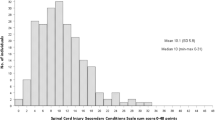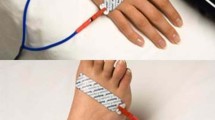Abstract
Study design:
Case–control study.
Objectives:
To investigate changes of biomechanical skin properties and their relationship with paralysis following spinal cord injury (SCI).
Setting:
South Korea.
Methods:
A total of 48 male subjects with chronic SCI and 48 age-matched healthy controls were enrolled into this study. The C4 shoulder group and L2 thigh group were prescribed by two measured anatomical regions that represented the C4 and L2 American Spinal Injury Association sensory dermatomes. Each anatomical group was comprised of one control subgroup and three SCI subgroups determined by sympathetic paralysis at the measured region and somatic completeness. The following biomechanical skin properties were compared between the subgroups in each anatomical group by using Cutometer, a non-invasive suction device: distensibility (Uf), elasticity (Ua/Uf and Ur/Uf) and viscoelasticity (Uv/Ue and H). The impact of sympathetic and somatic sensory paralysis, somatic completeness, age, smoking, body mass index and duration of injury on the indices of skin properties were analyzed.
Results:
In each anatomical group, sympathetic paralyzed subgroups regardless of somatic sensory completeness showed lower value of skin distensibility (Uf), and higher values of elasticity (Ua/Uf and Ur/Uf) and viscoelasticity (Uv/Ue and H), compared with other subgroups. Age and duration of injury had significant impact on biomechanical skin properties.
Conclusion:
The non-invasive suction method is useful for quantitative evaluation of skin affected by SCI. In chronic SCI patients, biomechanical skin properties are significantly altered in the skin with sympathetic paralysis rather than somatic sensory paralysis.
Similar content being viewed by others
Log in or create a free account to read this content
Gain free access to this article, as well as selected content from this journal and more on nature.com
or
References
Rubin-Asher D, Zeilig G, Klieger M, Adunsky A, Weingarden H . Dermatological findings following acute traumatic spinal cord injury. Spinal Cord 2005; 43: 175–178.
Stover SL, Hale AM, Buell AB . Skin complications other than pressure ulcers following spinal cord injury. Arch Phys Med Rehabil 1994; 75: 987–993.
Claus-Walker J, Halstead LS . Metabolic and endocrine changes in spinal cord injury: II (section 1). Consequences of partial decentralization of the autonomic nervous system. Arch Phys Med Rehabil 1982; 63: 569–575.
Vaziri ND, Eltorai I, Gonzales E, Winer RL, Pham H, Bui TD et al. Pressure ulcer, fibronectin, and related proteins in spinal cord injured patients. Arch Phys Med Rehabil 1992; 73: 803–806.
Stover SL, Gay RE, Koopman W, Sahgal V, Gale LL . Dermal fibrosis in spinal cord injury patients: a scleroderma variant? Arthritis Rheum 1980; 23: 1312–1317.
Rappl LM . Physiological changes in tissues denervated by spinal cord injury tissues and possible effects on wound healing. Int Wound J 2008; 5: 435–444.
Alexander MS, Biering-Sorensen F, Bodner D, Brackett NL, Cardenas D, Charlifue S et al. International standards to document remaining autonomic function after spinal cord injury. Spinal Cord 2009; 47: 36–43.
Sato K, Kang WH, Saga K, Sato KT . Biology of sweat glands and their disorders. I. Normal sweat gland function. J Am Acad Dermatol 1989; 20: 537–563.
Elsner P . Skin elasticity. In: Berardesca E, Elsner P, Wilhelm KP, Maibach HI (eds). Bioengineering of the skin: Methods and Instrumentation. CRC Pr: Boca Raton, 1995, pp 53–64.
Nedelec B, Correa JA, Rachelska G, Armour A, LaSalle L . Quantitative measurement of hypertrophic scar: interrater reliability and concurrent validity. J Burn Care Res 2008; 29: 501–511.
Barel AO, Courage W, Clarys P . Suction method for measurement of skin mechanical properties: the Cutometer. In: Serup J, Jemec GB (eds). Handbook of Non-Invasive Methods and the Skin, vol. 106. CRC Pr: Boca Raton, 1995, pp 335–340.
Smalls LK, Randall Wickett R, Visscher MO . Effect of dermal thickness, tissue composition, and body site on skin biomechanical properties. Skin Res Technol 2006; 12: 43–49.
Ryu HS, Joo YH, Kim SO, Park KC, Youn SW . Influence of age and regional differences on skin elasticity as measured by the Cutometer. Skin Res Technol 2008; 14: 354–358.
Dobrev HP . In vivo study of skin mechanical properties in psoriasis vulgaris. Acta Derm Venereol 2000; 80: 263–266.
Yoon HS, Baik SH, Oh CH . Quantitative measurement of desquamation and skin elasticity in diabetic patients. Skin Res Technol 2002; 8: 250–254.
Maynard Jr FM, Bracken MB, Creasey G, Ditunno Jr JF, Donovan WH, Ducker TB et al. International Standards for Neurological and Functional Classification of Spinal Cord Injury. American Spinal Injury Association. Spinal Cord 1997; 35: 266–274.
Thomas A . Les moyens d’exploration du systeme sympathique et leur valeur: Affections organiques du systeme nerveux. Rev Neurol 1926; 1: 767–928.
List CF, Pimenta AD . Sweat secretion in man: VI. Spinal reflex sweating. Arch of Neurol Psychiatry 1944; 51: 501–507.
Previnaire JG, Soler JM, El Masri W, Denys P . Assessment of the sympathetic level of lesion in patients with spinal cord injury. Spinal Cord 2009; 47: 122–127.
Ohry A, Rozin R . Clinical note on facies quadriplegiae. Paraplegia 1983; 21: 327.
Author information
Authors and Affiliations
Corresponding author
Ethics declarations
Competing interests
The authors declare no conflict of interest.
Rights and permissions
About this article
Cite this article
Park, J., Seo, C., Han, S. et al. Sympathetic influence on biomechanical skin properties after spinal cord injury. Spinal Cord 49, 236–243 (2011). https://doi.org/10.1038/sc.2010.95
Received:
Revised:
Accepted:
Published:
Issue date:
DOI: https://doi.org/10.1038/sc.2010.95



